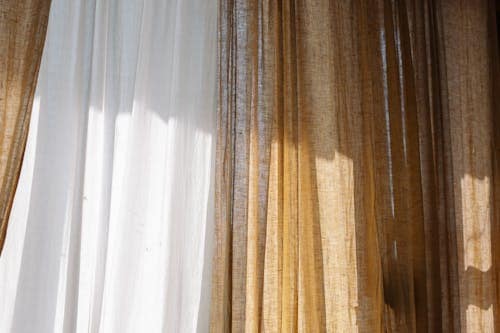Natural fiber in interior design blends sustainability, comfort, and timeless style by using eco-friendly materials like jute, bamboo, linen, and organic cotton. These sustainable home decor materials not only reduce environmental impact but also enhance indoor air quality, create cozy textures, and support a healthier home. Whether it is a jute carpet in the living room or linen curtains in the bedroom, natural fibers help you build a beautiful space that reflects your eco-conscious lifestyle.
Introduction
Have you ever walked into a room and instantly felt calm, grounded, and inspired? Chances are, natural materials played a big part in creating that feeling. In today's world, where our homes double as sanctuaries, workspaces, and gathering places, it is more important than ever to design with intention, and sustainability.
Natural fiber in interior design is more than a beautiful aesthetic. It is a conscious choice that supports your well-being and the planet. Yet many homeowners and renters still struggle with where to start, what materials to trust, and how to use them without sacrificing comfort or style.
In this post, you will discover how to confidently use sustainable home decor materials, like jute, bamboo, linen, and organic cotton, to create a healthier, more inviting space. You will learn the benefits of natural fibers, how to choose the right materials for different rooms, the best products to try, and how to care for them so they last for years.
Whether you are refreshing a single room or rethinking your entire home, this guide will help you blend eco-conscious choices with timeless design.
I. What Are Natural Fibers and Why Should You Use Them in Your Home?
Natural fibers are materials sourced from plants or animals that are minimally processed and biodegradable. Examples include cotton, linen, jute, hemp, bamboo, wool, and silk. These materials are often chosen for their breathability, durability, texture, and low environmental footprint.
A. Benefits of using natural fibers in interior design:
- Improves indoor air quality by avoiding synthetic chemicals
- Creates a warm and organic feel in your space
- Reduces reliance on plastic and petroleum-based materials
- Supports traditional craftsmanship and local artisans
- Contributes to a lower carbon footprint
II. Best Natural Fiber Rugs to Add Texture and Warmth
Rugs are one of the easiest ways to introduce natural fiber into your home. They anchor a space and add both comfort and character. Among the most searched and loved options are:
A. Popular natural fiber rugs:
Rug Type | Best For |
|---|---|
Jute Rugs | Living rooms and entryways for a rustic, earthy feel |
Sisal Rugs | High-traffic areas like hallways and offices |
Hemp Rugs | Eco-conscious homes needing durable flooring |
Wool Rugs | Bedrooms and cozy corners for softness and warmth |
Tip: Layer a natural fiber rug under a colorful vintage or patterned rug for a rich and textured look.
III. How to Choose Eco-Friendly Furniture Fabrics
Upholstery and soft furnishings are often overlooked when it comes to sustainability. Many conventional fabrics contain synthetic fibers, dyes, and flame retardants. Switching to eco-friendly furniture fabrics made from natural fibers is a smart and health-conscious choice.
A. Top fabric options for sustainable furniture:
- Organic cotton: breathable and soft
- Linen: durable and naturally antibacterial
- Hemp: resistant to wear and tear
- Wool: moisture-wicking and long-lasting
Look for third-party certifications such as GOTS (Global Organic Textile Standard) or OEKO-TEX to ensure the fabric meets environmental and health standards.
IV. Bamboo Home Accessories That Are Both Beautiful and Practical
Bamboo is one of the fastest-growing plants in the world and requires minimal water and no pesticides. This makes it a top pick for sustainable home decor.
A. Popular bamboo home accessories:
- Storage baskets and trays
- Pendant lighting and lampshades
- Bamboo chairs and side tables
- Bathroom accessories like toothbrush holders or towel racks
- Bamboo kitchen organizers and utensil holders
Tip: Choose natural-finish bamboo items to preserve the organic look and reduce chemical treatments.

Linen curtains for eco-friendly interior design materials
V. Natural Curtains Materials That Let Your Home Breathe
Window treatments often trap dust and VOCs when made from synthetic materials. Choosing curtains made from natural fibers allows for better air circulation and gives your home a soft, calming ambiance.
A. Best materials for natural curtains:
- Linen: lightweight and flowy with a timeless look
- Cotton: versatile and easy to wash
- Hemp: textured and eco-friendly
- Bamboo blends: sustainable and semi-sheer
Pair them with wooden or bamboo curtain rods for a complete natural look.
VI. Jute Carpets and Area Rugs for a Grounded, Earthy Vibe
Jute is a favorite for its rustic charm and golden-brown tones. It is a low-impact crop that grows quickly with little intervention, making it one of the most sustainable fibers available.
A. Why choose jute carpets:
- Soft underfoot and naturally textured
- Excellent for casual, beachy, or bohemian interiors
- Affordable and renewable
- Blends easily with both minimal and bold interiors
Maintenance tip: Use in low to medium traffic areas to maintain its shape and beauty longer.
VII. Room-by-Room Guide to Using Natural Fiber Decor
A. Living Room:
Use jute or wool rugs, hemp throw pillows, linen curtains, and a bamboo coffee table.
B. Bedroom:
Layer organic cotton or linen bedding, add a wool area rug, and place a bamboo tray on your nightstand.
C. Bathroom:
Hang a natural linen shower curtain, place a bamboo bath mat, and organize with jute baskets.
D. Dining Area:
Choose a hemp table runner, linen napkins, and rattan or bamboo placemats.
VIII. How to Take Care of Natural Fibers in Your Interior Design
Natural fibers are beautiful and durable, but they require a little extra love to keep them looking their best. Proper care helps extend the life of your sustainable home decor materials and keeps your home fresh and healthy.
A. General Tips for All Natural Fibers
- Keep out of direct sunlight to prevent fading
- Vacuum or shake out rugs and fabrics regularly to remove dust and allergens
- Avoid harsh chemical cleaners and opt for natural cleaning solutions
- Address spills immediately with gentle blotting, not scrubbing
- Use a dehumidifier in humid climates to prevent mold and mildew
B. Caring for Specific Natural Fiber Materials
1. Jute and Sisal Rugs:
- Spot clean with a damp cloth and mild soap
- Avoid placing in high-moisture areas like bathrooms
- Use rug pads to reduce wear and slippage
2. Linen Curtains and Upholstery:
- Hand wash or machine wash on gentle cycle with mild detergent
- Air dry to maintain shape and texture
- Iron on low if needed, or embrace the natural wrinkle for a relaxed look
3. Bamboo Accessories:
- Wipe with a dry or slightly damp cloth
- Avoid soaking or placing in standing water
- Use natural oils (like linseed or mineral oil) to maintain shine
4. Wool Rugs and Throws:
- Vacuum with a brushless attachment to prevent pulling
- Spot clean with water and white vinegar or gentle wool cleaner
- Air out periodically to keep fresh and deter moths
5. Hemp and Cotton Textiles:
- Machine wash in cold or warm water
- Line dry or tumble dry on low
- Use natural detergents to maintain fiber integrity
Frequently Asked Questions
What are the most common natural fibers used in home decor?
Some of the most popular natural fibers in interior design include jute, hemp, linen, cotton, bamboo, wool, and sisal. These materials are loved for their durability, breathability, and sustainable qualities.
Are natural fiber rugs good for high-traffic areas?
Yes, certain natural fiber rugs like sisal and hemp are durable enough for high-traffic areas such as hallways and entryways. However, jute rugs are better suited for low to medium-traffic spaces due to their softer weave.
Do natural fibers require special cleaning products?
No, most natural fibers can be cleaned with simple, gentle products like diluted vinegar, mild soap, or baking soda. Avoid harsh chemical cleaners, as they can damage the fiber and affect indoor air quality.
Can I use natural fiber materials in a humid climate?
Yes, but with care. Natural fibers like jute, wool, and bamboo can absorb moisture, so proper ventilation and regular airing are important. Use a dehumidifier in very humid environments and avoid placing natural fiber rugs in bathrooms or wet areas.
Are natural fiber furnishings safe for people with allergies?
Generally, yes. Natural fiber materials are less likely to emit volatile organic compounds (VOCs) than synthetic options. Materials like organic cotton, hemp, and wool are breathable and hypoallergenic, making them suitable for people with sensitivities.
What is the best way to remove stains from a jute or sisal rug?
Blot the spill immediately with a clean, dry cloth. Then gently dab with a mix of water and mild soap. Avoid soaking the rug and let it air dry completely. For stubborn stains, spot treat with a vinegar-water solution and test on a small area first.
How can I tell if a fabric or rug is truly eco-friendly?
Look for third-party certifications such as GOTS (Global Organic Textile Standard), OEKO-TEX, or FSC for wood-based accessories. These labels indicate that the product meets environmental and health safety standards.
Is bamboo a sustainable material?
Yes, bamboo is considered highly sustainable because it grows rapidly, needs little water, and does not require pesticides. It is a popular choice for eco-conscious homes when harvested and processed responsibly.
Final Thoughts
Natural fiber in interior design offers beauty with purpose. By choosing sustainable home decor materials like jute carpets, natural curtains, eco-friendly fabrics, and bamboo accessories, you are not only creating a stylish and welcoming space, but you are also making a positive impact on the planet.
Take it one room at a time. Swap synthetic for natural. Let your home reflect the values you live by: clean, conscious, and beautifully sustainable.
I encourage you to try my Free 30-Day Natural Ingredient Swap Challenge. It will help you develop a habit in natural ingredient awareness in everyday living.

 Simple. Natural. Better.
Simple. Natural. Better.